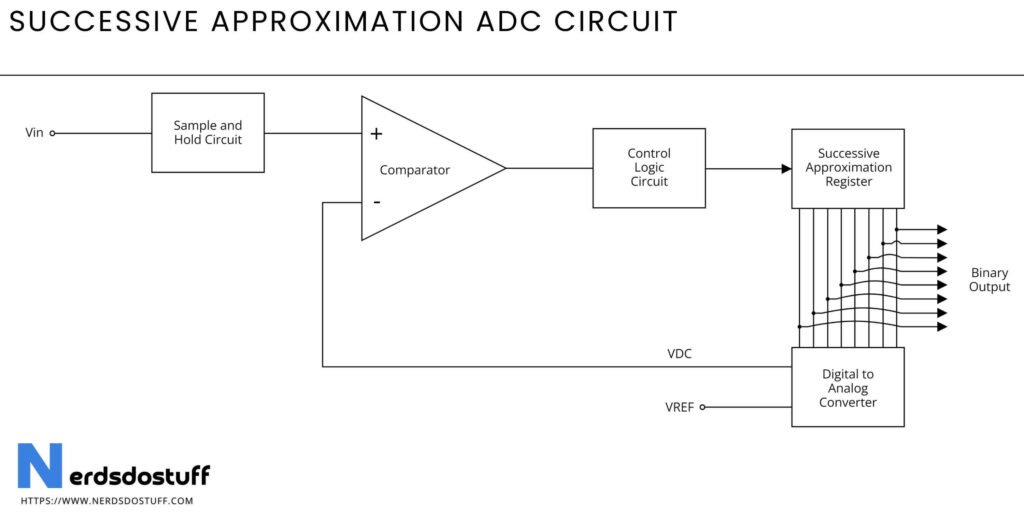What is Successive Approximation ADC ?
A successive approximation ADC (Analog-to-Digital Converter) is a type of ADC that converts an analog input signal into a digital output through a methodical and iterative process. This type of ADC uses a successive approximation register (SAR) to approximate the input voltage step-by-step. The conversion process begins by setting the most significant bit (MSB) of the digital output to 1 and comparing the resulting analog voltage (from a DAC) to the input signal. If the DAC output is higher than the input, the MSB is set back to 0. If it is lower, the MSB remains 1. This process is repeated for each subsequent bit, moving from the MSB to the least significant bit (LSB), refining the approximation of the input voltage at each step.
The key advantage of the successive approximation ADC lies in its balance of speed and resolution. It offers faster conversion times compared to integrating ADCs and higher accuracy than flash ADCs, making it suitable for a wide range of applications. The SAR ADC’s structure, consisting of a comparator, a DAC, and a control logic unit, allows it to provide precise digital representations of analog signals efficiently. This makes it ideal for use in applications such as digital multimeters, data acquisition systems, and various types of sensor interfaces where accurate and rapid analog-to-digital conversion is essential.
Successive Approximation ADC Circuit Diagram

Working of Successive Approximation ADC
The operation of a successive approximation ADC begins with the initialization of the successive approximation register (SAR) to its mid-point value, which corresponds to setting the most significant bit (MSB) to 1 and all other bits to 0. This digital value is then fed into a digital-to-analog converter (DAC) within the ADC, which generates an analog voltage corresponding to the MSB being set. This generated voltage is compared to the input analog voltage using a comparator. If the generated voltage is higher than the input, the MSB is reset to 0; if lower, the MSB remains 1. This step sets the reference for the highest bit position.
Next, the SAR adjusts to the next significant bit by setting it to 1 while keeping the MSB as previously determined. The DAC converts this new digital value to an analog voltage, which is again compared to the input voltage. The comparator checks this new voltage: if it is higher than the input, the current bit is reset to 0; if lower, it remains 1. This process is repeated for each bit, moving sequentially from the MSB to the least significant bit (LSB). Each comparison refines the digital output, narrowing down the approximation to the actual input voltage.
This iterative process continues until all bits in the SAR have been tested and set accordingly. By the end of the process, the SAR holds a binary value that closely approximates the input analog voltage. The final digital value in the SAR represents the digital equivalent of the input analog signal, completing the conversion.
Applications of Successive Approximation ADC
- Digital Multimeters:
- Successive approximation ADCs are widely used in digital multimeters to measure voltage, current, and resistance with high precision and accuracy. The ADC converts the analog signals from the probes into digital data that can be displayed and analyzed.
- Data Acquisition Systems:
- In data acquisition systems, these ADCs convert analog signals from sensors and other input devices into digital data for processing, storage, and analysis. Their balance of speed and accuracy makes them ideal for applications in scientific research and industrial monitoring.
- Medical Instrumentation:
- Medical devices such as electrocardiograms (ECGs), blood pressure monitors, and medical imaging equipment rely on successive approximation ADCs to convert physiological signals into digital form for diagnosis, monitoring, and analysis.
- Automotive Systems:
- In automotive electronics, successive approximation ADCs are used in engine control units (ECUs), antilock braking systems (ABS), and other vehicle sensors to convert analog signals into digital data for real-time monitoring and control of vehicle functions.
- Digital Oscilloscopes:
- Digital oscilloscopes use successive approximation ADCs to convert analog input signals into digital data for display and analysis. The fast conversion speed and accuracy of these ADCs allow for precise waveform capture and measurement.
- Communication Systems:
- Successive approximation ADCs are used in communication systems for signal processing tasks such as analog-to-digital conversion in modems, software-defined radios (SDRs), and other digital communication devices. They ensure accurate and efficient conversion of analog signals to digital form for further processing and transmission.




